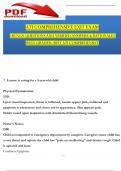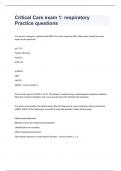ATI COMPREHENSIVE EXIT EXAM
180 NGN QUESTIONS AND VERIFIED ANSWERS & RATIONALES
WELL GRADED, BEST ATI COMPREHENSIVE
1. A nurse is caring for a 5-year-old child
Physical Examination:
1510:
Upon visual inspection, throat is inflamed, tonsils appear pink, reddened and
epiglottis is edematous and cherry red in appearance. Skin appears pale.
Stridor noted upon inspiration with diminished bilateral lung sounds.
Nurse's Notes:
1500
Child accompanied to emergency department by caregiver. Caregiver states child has
a sore throat and reports the child has "pain on swallowing" and denies cough. Child
is agitated and lean:
Condition: Epiglottis
,Actions: Initiate droplet precautions and request a prescription for IV antibiotics Monitors:
Breath sounds and temperature
The nurse should anticipate initiating droplet precautions and requesting a prescrip- tion for IV
antibiotics. The child is most likely experiencing epiglottis because of the clinical
manifestations of a high fever, inflammation and redness of the throat, pale skin, stridor with
inspiration, painful swallowing, no cough, is sitting in tripod position, and drooling. The nurse
should monitor the child's temperature and breath sounds.
2. A nurse is caring for a client who is on the spinal cord injury (SCI) unit
Nurses' Notes
Day 3, 1700
Client admitted to SCI unit 3 days ago following C7 injury. Skin is cool, pale, and dry
to touch. Respirations easy and unlabored. Lung sounds diminished in lower lobes.
Abdomen soft and nondistended with active bowel sounds.
Client passed a small amount of hard formed stool this AM. Indwelling urinary catheter
draining clear yellow urine. Deep tendon reflexes (DTR) are biceps 1+, triceps 1+, pa:
The client is most likely experiencing manifestations of pneumonia and autonomic dysreflexia.
The nurse should analyze cues from the client's manifestations and determine that the client is
most likely experiencing manifestations of pneumonia and autonomic dysreflexia. A client
who has a cervical SCI is at risk for respiratory complications because spinal innervation to
the respiratory muscles is disrupted. Adventitious breath sounds in the lower lobes bilaterally
and a decrease in oxygen saturation
to less than 92% can indicate pneumonia. The client's sudden increase in blood
,pressure, bradycardia, flushing of the skin above the area of the injury, headache,
and blurred vision are manifestations of autonomic dysreflexia, which can be a life-
threatening condition.
3. A nurse is caring for a client who has abdominal pain
Nurses' Notes
0900
Client reports loss of appetite, weight loss, and fatigue for 1 week. Reports abdominal
pain, 6 on a scale from 0 to 10, for 2 days. Client is a perioperative nurse, returned 1
week ago from a 2-week mission trip to an underdeveloped country
1200
Results of antibody studies obtained. Provider prescription for antiviral med- ication
pending.
Physical Examination
0930
Lung sounds clear bilaterally. Skin warm to touch and jau: Hepatitis A: Client's risk from
fecal-oral transmission, laboratory results, and physical examination find- ings
Hepatitis B: Antiviral treatment, laboratory results, client's risk from bloodborne transmission,
physical examination findings
Hepatitis C: Antiviral treatment, laboratory results, client's risk from bloodborne transmission,
and physical examination findings
,When analyzing cues, the nurse should recognize that manifestations of hepatitis A, hepatitis B,
and hepatitis C include jaundice, yellow sclerae, right upper quandrant pain upon palpation,
dark yellow urine, and elevated AST and ALT levels. When analyzing cues, the nurse should
also recognize the client's risk for contracting hepatitis A through the fecal-oral route during
recent travel to an underdeveloped country and the client's occupational risk as a
perioperative nurse for contracting hepatitis B and hepatitis C through bloodborne
transmission. The nurse should recognize that the current standard of practice for
4. A nurse is caring for a client on a medical-surgical unit
Vital Signs
,0700
Temperature 37.6 C (99.7 F)
Heart rate 100/min Respiratory
rate 22/min Blood pressure
115/70 mmHg
Oxygen saturation 98% on room air
Nurses' Notes 1100
Client alert and oriented to person, place, and time. Client had episode of diarrhea,
provided perineal care. Noted 2 cm x 2 cm (0.8 in x 0.8 in) painful edematous area on
sacrum. Client repositioned every 4 hr.:
Click to highlight the findings that require follow up. To deselect a finding, click on the finding
again.
- Noted 2 cm x 2 cm (0.8 in x 0.8 in) painful edematous area on sacrum
- Client repositioned every 4 hr
When recognizing cues, the nurse should determine that the client's painful edema- tous area
on their sacrum and that the client has only been repositioned every 4 hr requires follow up.
The client has manifestations of a pressure injury that need to be addressed. The client should
be repositioned at least every 2 hr to prevent worsening of the pressure injury and to relieve
pressure from the sacral area.
5. A nurse in an outpatient mental health clinic is caring for a client
Vital Signs
3 months ago
,Blood pressure 116/68 mmHg
Heart rate 82/min
Respiratory rate 16/min
Temperature 36.7 C (98.1 F)
SaO2 97% on room air
Today:
Blood pressure 128/76 mmHg
Heart rate 104/min Respiratory
rate 22/min Temperature 37.4
(99.4 F) SaO2 97% on room air
Nurses' Notes
,3 months ago
Client recently admitted with new diagnosis of schizophrenia. Received in- patient
treatment for 10 days and was discharged 1 week ago.: Select the 3 findings that
require immediate follow up:
- Auditory hallucinations
- Speech
- Restlessness
When recognizing cues, the nurse should identify that the findings of restlessness, auditory
hallucinations, and pressured speech require immediate follow up. These findings are
indications of psychosis. The nurse should notify the provider for addi- tional evaluation and
treatment.
6. A nurse is caring for a client who is postoperative following coronary artery bypass
surgery (CABG)
Laboratory Results 0630
Sodium 145 mEq/L (136 to 145 mEq/L)
Potassium 3.2 mEq/L (3.5 to 5 mEq/L)
Chloride 116 mEq/L (98 to 106 mEq/L)
BUN 24 mg/dL (10 to 20 mg/dL)
Magnesium 1.5 mEq/L (1.3 to 2.1 mEq/L)
Total calcium 9 mg/dL (9 to 10.5 mg/dL)
Phosphate 4.6 mg/dL (3 to 4.5 mg/dL)
Glucose 95 mg/dL (74 to 106 mg/dL)
WBC count 9,500/mm3 (5,000 to 10,000/mm3)
,I&O
0700
4 hr input 400 mL
4 hr output: The client is at greatest risk for developing dysrhythmias, as evidenced by
electrolyte imbalance.
The nurse should analyze cues to determine the client is at greatest risk for devel- oping
dysrhythmias related to hypokalemia, as evidenced by the laboratory report and the client's
report of muscle cramping. Potassium and magnesium depletion are common manifestations
in clients who are postoperative following CABG. Due to medication or hemodilation, it is
important for the nurse to closely monitor electrolytes.
,7. A nurse is caring for a client who is pregnant in the acute care setting
Nurses' Notes
1400
Client reports a constant low dull backache and painless abdominal tightening for the
past 3 hr. Denies any changes in vaginal discharge. External fetal monitor applied.
1430
Contraction pattern: contractions every 4 to 5 min, lasting 30 to 45 seconds, palpate
mild in intensity
Fetal heart rate: 150/min to 155/min, moderate variability, adequate accel- erations
present, no decelerations noted. Provider in: The nurse should first address the client's
respiratory rate, followed by the client's level of consciousness
When prioritizing hypotheses, the nurse should recognize that magnesium sulfate is a central
nervous system depressant that can affect respirations, consciousness, and reflexes when toxic
blood levels occur. Using the airway, breathing, circulation priority framework, the nurse
should plan to first take action to support respira- tions, followed by action to increase the
client's level of consciousness. The nurse should plan to discontinue the magnesium sulfate
infusion and administer calcium gluconate as an antidote.
8. A nurse is caring for an adolescent in the emergency department (ED)
Nurses' Notes
0700
Adolescent admitted to ED. Adolescent's parents are concerned about left leg injury
that appears to be getting worse. Parents report adolescent has had fever, decreased
, appetite, and decreased energy within the past 2 days. Adolescent reports leg injury
occurred while playing soccer.
0715
Adolescent is alert and oriented to person, place, time, and situation. Adoles- cent
reports left lower leg pain as 4 on: Which of the following findings requires immediate
follow up by the nurse?
- Skin assessment
- Temperature
- WBC
- Casual blood glucose
10 /
79





